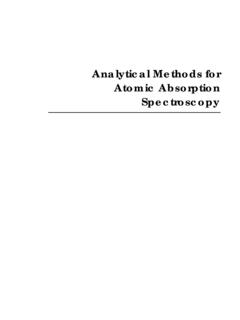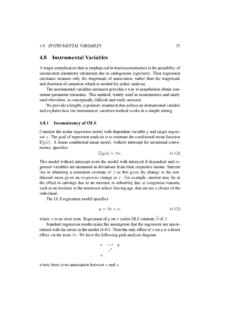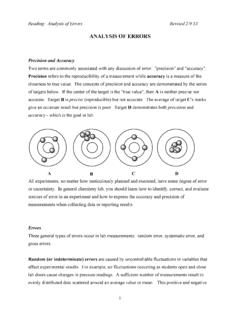Transcription of Instrumental Analysis Lab Manual - La Salle University
1 Fall 2018 M. J. Prushan CHL 311 Instrumental Analysis Lab Manual 1 Table of Content CHM 311 Laboratory Schedule .. 2 Instrumental Analysis Laboratory Policies .. 3 Instrumental Analysis Instrumentation Contract .. 5 MODULE I: SPECTRAL SOURCES AND SIGNAL TO NOISE Experiment 1 BLACKBODY RADIATION or What s the difference between a light bulb and the sun? .. 10 Experiment 2 SPECTROSCOPY TRADING RULES: Signal-to-Noise, Resolution, Ensemble Averaging, Digital Smoothing .. 12 MODULE II: SPECTROPHOTOMETERS: Instrumentation and Applications Experiment 3 DETERMINATION OF CHLOROPHYLL IN OLIVE OIL by UV-Visible and Fluorescence Spectroscopy .. 17 Experiment 4 PERFORMANCE CHARACTERISTICS OF A SPECTROPHOTOMETER or Introduction to Ultraviolet Visible Spectrometry (UV-Vis) .. 22 Experiment 5 SPECTROPHOTOMETRIC Analysis OF A MIXTURE, Determination of caffeine and benzoic acid in a soft drink.
2 32 Experiment 6 FLUORESCENCE Spectroscopy .. 36 MODULE III: CHROMATOGRAPHY Experiment 7 QUALITATIVE GAS CHROMATOGRAPHY: The Van Deemter plot and optimum separation Experiment 8 IMPOSTER vs. REAL PERFUMES via GC-MS .. 54 Experiment 9 DRUGS ON MONEY: GC-MS determination of cocaine on paper money .. 62 Appendix I INSTRUMENT INSTRUCTIONS .. 65 Appendix II USE OF A MICROSYRINGE FOR GC .. 70 2 Instrumental Analysis Laboratory Policies INTRODUCTION In the laboratory portion of Instrumental Analysis you will be exposed to several different types of Instrumental techniques. In most experiments, you will be investigating the performance characteristics of the instrument in addition to using it to make a measurement. It is still important, however, that you continue to use your best analytical technique when preparing standards and samples. Poor technique will always produce poor results!
3 LABORATORY MODULES The laboratory course is divided into three modules, each of which emphasizes a different aspect of Instrumental Analysis . Each module consists of 2-4 experiments that relate to the theme of the module. You will work as part of a 2-person group, but because of limited instrument availability there is a possibility that you will have to schedule Analysis time outside of class. LAB PREPARATION The key to efficiency in the lab is preparation. You are expected to read the lab and contact the instructor before the lab period for questions and/or clarifications. It is highly recommend that you consult with your group members before the lab period to divide responsibilities so that your laboratory time is used most efficiently. It is also important that you are considerate of your lab partners and arrive at lab on time. LAB NOTEBOOK You must keep a lab notebook starting with the first day of experiments.
4 All data must be recorded in the laboratory notebook, not on loose sheets of paper or on the lab Manual . To prevent abuse ( filling in the notebook at the end of the semester), you must get the signature of the lab instructor each week. The primary purpose of the laboratory notebook is to record data and experimental details that are not included in the lab Manual . You do not need to rewrite procedures that are already in the laboratory Manual , and you do not need to include calculations. The notebook will be graded based on the following guidelines: 1. The first few pages of the notebook should be reserved for a table of contents. This table of contents should be kept up to date. 2. Each page should have a page number and be dated. 3. The notebook must be hard bound. 4. No pages should be removed for any reason. 5. All data entries must be in indelible ( non-erasable) ink.
5 6. Mistakes and errors should be crossed out with a single line. White-out is not allowed. 7. Try to keep the notebook reasonably neat you should be able to understand each entry. It is often helpful to construct tables prior to lab and fill them out as you collect data. 8. Keep your notebook current. It is unethical (not to mention illegal in many circumstances) to go back and fill in your notebook with data you wrote on loose pieces of paper. Backdating ( going back and writing the date you think the data was recorded) is also forbidden. 3 REPORTS You must write a report (full, short or poster lab report) for each experiment. These reports are due one week after completing the lab. IMPORTANT Reports are due at the beginning of the lab period. YOU MAY NOT WORK ON YOUR LAB REPORTS DURING THE LAB PERIOD. You are encouraged to work with your partners on analyzing your data.
6 However all written work must be individual efforts. Your report must be written in your own words and contain your own calculations and interpretations. Copied reports will result in a failure in the course. Lab reports will not be accepted from anyone that has missed an experiment. You may not simply copy your partners data and turn a report; you must arrange to do the experiment (preferably during another lab period). GENERAL REPORT FORMATTING Reports must be printed with a high quality printer. Answer all questions completely and in paragraph form. Do not merely answer yes or no , but always give a rationale for your answer. Here is an example of an answer that would receive full credit: What is the optimal flame observation height for Zr? The data in Figure 3, a plot of Zr absorbance as a function of observation height in the flame, shows that the maximum absorbance occurs at a height of cm.
7 Therefore, the best sensitivity for atomic absorption of Zr occurs at an observation height of cm. Be sure to include sample calculations. Handwritten calculations are acceptable. Sample calculations should be easy to follow. When fitting data to a line ( a calibration curve), always use linear regression. Report the equation for the line and the correlation coefficient (r or r2). For all replicate determinations, the average, standard deviation, and % relative standard deviation must be reported. The following are examples of acceptable presentation of data. Note that tables include descriptive captions and that columns include units. 4 The following is an example of a poorly-constructed table. This table does not have a descriptive title, lacks units, has poor labeling of the samples, has totally ignored significant figures, is poorly aligned, and has no column for %RSD.
8 GRAPHING Good graphical presentation of data is critical for Analysis of experimental results. Listed below are general guidelines for properly plotting and annotating a graph. 1. Choose a scale that best shows the full dimensions of the data and also results in scale divisions that allow easy interpretation of the data. In other words, do not bunch the data in one corner of the graph. Most spreadsheets scale graphs automatically, but you can usually re-scale the graph manually. The origin need not be included in the graph unless you are showing data near the origin. 2. Plot the dependent variable (the one that is a function of the other, such as absorbance as a function of concentration) on the vertical axis. The independent variable should therefore be plotted on the horizontal axis. Always label both axes and include units in parentheses. 5 3. Each point should be located with a small distinct data point.
9 Use different symbols ( circles, squares, etc.) to distinguish one data set from another. 4. Lines through data sets should not connect the dots . The best method (if the data is supposed to be linear) is to use linear regression to determine the best-fit line for your data. 5. Never let Excel draw a smooth line through your data. In nearly every case, these curves are meaningless! 6. When you plot data over several orders of magnitude, it is advisable to construct a log-log plot so that data at both low and high concentrations are visible. Although you can do this by setting the properties of the axis in Excel to logarithmic , it is usually best to calculate the logarithm of the data before graphing (especially when you want to make a linear fit to the log-log data). 6 [INSTRUCTOR COPY] CHL 311 Laboratory Instrumentation Contract The Instrumental techniques that you will be learning are critical tools in so many areas of science, not only in chemistry but also in medicine, geology, food science, forensic science, environmental and agricultural science, material science, and pharmaceutical science as well.
10 You will have a lot of independence and opportunity to control your own work schedule. However, because of the structure of the course, much of the responsibility for your education rests with you. You will also have responsibility at times for the use and care of nearly $500,000 worth of equipment. Often others will depend on your effort and cooperation. In order for everyone to get the most out of this course and to protect you and the instrumentation we must agree to abide by some rules. Please read the following statements about expectations and use of facilities. Failure to follow these rules will result in a failing grade in the course. 1. I will follow safe working procedures in lab. If the proper practice is unclear, or questionable in my opinion, I will ask the instructor about it. 2. I agree not to eat or drink in the lab, nor to bring open beverages or containers of food into the lab.














